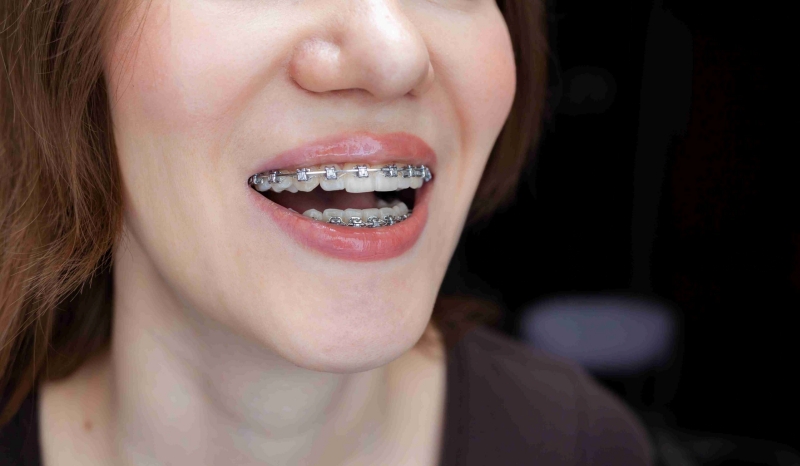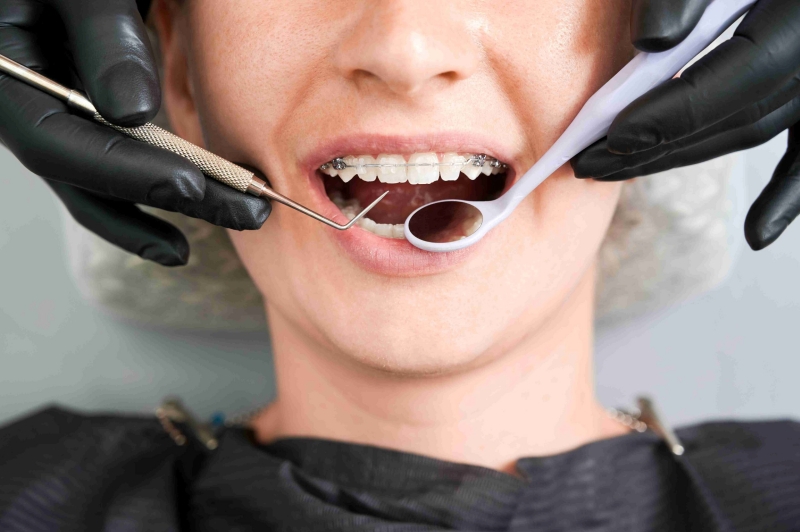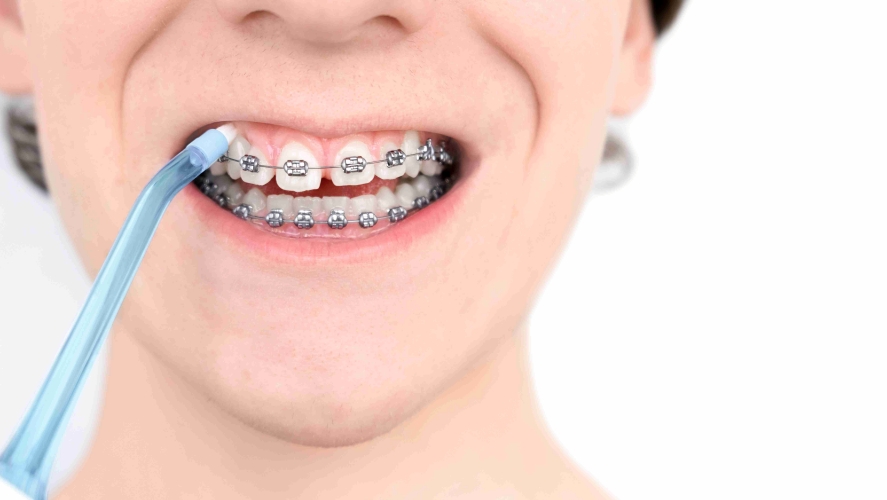What are Self-ligating braces? How Many Types Are There, and Which Type Is Best for Your Teeth?
For anyone exploring options beyond traditional metal braces, self-ligating braces could be the modern solution you’re looking for. But what exactly are they, how do they differ from metal braces, and who are they best suited for?
In today’s world of advanced dental technology, self-ligating braces are gaining popularity. Known as “braces without elastic ties,” this innovation offers faster treatment times, less discomfort, and easier maintenance. Additionally, they provide a more discreet appearance, allowing wearers to smile confidently even with braces.
If you’re considering this cutting-edge orthodontic treatment, let’s delve into what self-ligating braces are, the tools involved, and how to care for your teeth after choosing this method.
What Are Self-Ligating Braces?
Self-ligating braces are an innovative orthodontic solution that eliminates the need for elastic ties while effectively addressing issues such as gaps, crowding, misaligned teeth, and improper bite alignment. Recognized by medical professionals, this method can significantly reduce treatment time, deliver excellent results, and provide a more comfortable experience for patients.
Designed to minimize friction between the brackets and wires, self-ligating braces enhance the efficiency of tooth movement, reducing discomfort and irritation commonly associated with traditional braces.
How Do They Work?
elf-ligating braces use a built-in sliding mechanism or small clips to secure the archwire loosely, eliminating the need for rubber bands (O-rings). These braces combine the advantages of self-ligating brackets with high-tech archwires, enabling faster tooth movement.
With this system, patients don’t need to visit their orthodontist as frequently, making it a convenient option for achieving a beautifully aligned smile in less time.
Types of Self-Ligating Braces
At The Tooth Club, self-ligating braces are categorized into two types based on the brand of equipment used: Damon System and Speed Align. Here’s a detailed breakdown of each:
1. Damon System
A fixed self-ligating orthodontic solution, Damon braces are ideal for those with limited time who want quicker results with minimal discomfort. They utilize a Sliding Bracket combined with advanced Space-Age Archwires, enabling easier tooth movement without requiring tooth extractions.
Advantages:
- Shortens treatment time significantly.
- Minimal pain and irritation for patients.
- More comfortable compared to traditional braces.
- Fewer dental visits required.
- No need for tooth extractions or additional appliances.
Disadvantages:
- The metal components are visible.
- Fixed appliance—cannot be removed.
- Initial irritation as the mouth adjusts to the braces.
- Cleaning requires specialized tools and effort.
- May temporarily affect speech during the adjustment period.
2. Speed Align
Speed Align braces are another self-ligating system, similar to the Damon System. They work with the Speed System, combining Sliding Brackets with Space-Age Archwires to reduce friction, speeding up tooth alignment.
Advantages:
- Faster tooth movement reduces overall treatment time.
- May not require monthly visits to the dentist (in certain cases).
- Less pain compared to traditional braces due to reduced pulling force.
- Decreases the need for tooth extractions.
- Provides aesthetically pleasing results, enhancing smile and facial profile.
- Easier to clean, reducing the risk of cavities and gum disease.
Disadvantages:
- Requires specific cleaning tools for maintenance.
- Metal wires are visible.
- Initial irritation as the mouth adjusts to the braces.
- Speech may be slightly affected during the adjustment phase.
Each system offers unique benefits, so choosing the right one depends on individual needs and dental conditions.
How Self-Ligating Braces Work
Self-ligating braces use a locking mechanism that opens and closes, replacing the traditional elastic bands for applying pressure and securing the archwire. This innovative design eliminates the need for tight pulling to align teeth, making the treatment more comfortable and less painful compared to traditional braces.
Steps in Self-Ligating Orthodontic Treatment
- Consultation with a Dentist Evaluate the structure of your teeth through diagnostics such as impressions, X-rays, and photographs. Determine if self-ligating braces are the best solution for your dental condition.
- Oral Preparation Clear the mouth of potential issues by filling cavities, extracting impacted teeth, or scaling and cleaning.
- Fitting the Braces Schedule an appointment for attaching the self-ligating braces.
- Regular Adjustments Visit the dentist every 6-8 weeks for wire adjustments.
- Post-Treatment Retention Once the braces are removed, impressions are taken to create a retainer. Patients must wear the retainer as advised by the dentist to maintain the alignment.
Who is Self-Ligating Braces Suitable For?
- Individuals with Crowded or Misaligned Teeth
- Ideal for those with severe crowding, misalignment, or V-shaped dental and jaw structures.
- Self-ligating braces utilize highly flexible wires that expand the arch effectively, making them suitable for children under 18, whose jawbones are still adaptable.
- Those Seeking Fewer Dental Visits
- Perfect for individuals who prefer not to visit the dentist frequently.
- People Wanting a Subtle Appearance
- The metallic brackets are understated and present a polished, professional look, ideal for those conscious of visibility.
- Patients with Complex Dental Issues
- Best for cases requiring significant tooth movement to correct protrusions or tilts.
- This method reduces the overall time needed for alignment and causes less discomfort compared to traditional braces.
How Does Self-Ligating Braces Differ from Traditional Braces?
Traditional Braces:
- Mechanism:
- Use elastic bands to secure brackets to the archwire, creating the force needed to move teeth into alignment.
- The elastic bands apply high and inconsistent pressure, causing significant friction and discomfort.
- Pain and Adjustments:
- Patients often experience pain for the first 3–5 days after tightening.
- Regular monthly visits to the dentist are necessary to replace the bands and adjust the braces.
- Speed and Cost:
- Teeth alignment progresses more slowly due to inconsistent pressure.
- Popular for their affordability compared to other orthodontic methods.
Self-Ligating Braces:
- Mechanism:
- Use built-in clips or sliding mechanisms on the brackets to secure the archwire without elastic bands.
- Offers consistent and gentle pressure, reducing friction significantly.
- Pain and Adjustments:
- Less discomfort compared to traditional braces.
- Requires fewer dental visits, typically every 1.5 to 2 months.
- Speed and Efficiency:
- Teeth move more quickly and smoothly, achieving alignment in a shorter time frame.
- Ideal for individuals with limited time or those seeking quicker results with minimal pain.
Traditional braces are cost-effective but slower and more painful, whereas self-ligating braces offer a modern, efficient solution with faster results, less pain, and greater convenience.
Advantages of Self-Ligating Braces
- No Elastic Bands or Wire Tightening Needed Eliminates the discomfort and irritation often associated with traditional braces.
- Reduced Friction Less friction between the archwire and brackets allows for smoother, more efficient tooth movement.
- Shorter Treatment Time Teeth align faster, delivering quicker results compared to conventional methods.
- Easier to Maintain Oral Hygiene Simplified cleaning reduces the risk of cavities and gum disease.
- Fewer Dental Visits Patients don’t need frequent appointments for elastic band replacements or adjustments.
- Compact Design Smaller brackets offer greater comfort and enhance confidence when smiling or speaking.
- No Tooth Extraction Needed Often eliminates the need for tooth removal to create space for alignment.
How to Care for Yourself After Self-Ligating Braces
- Brush Regularly Brush your teeth at least twice a day or after every meal.
- Use a Soft-Bristled Toothbrush Opt for a toothbrush designed specifically for braces to reach all areas effectively.
- Fluoride Toothpaste Choose a toothpaste with fluoride to protect against cavities.
- Flossing Use floss specifically designed for braces to clean between teeth after every meal.
- Avoid Hard or Sticky Foods Stay away from foods that could damage the braces or cause discomfort.
- Regular Dental Checkups Visit your dentist every six months or as scheduled to monitor progress and make necessary adjustments.
- Address Issues Immediately If you notice any irregularities with your braces, such as broken brackets or loose wires, consult your dentist promptly.
FAQs
- Is it necessary to prepare your mouth before getting self-ligating braces?
Answer: Yes. Preparation is essential for all types of braces. Dentists must assess the condition of your teeth to determine the most suitable treatment plan. This step ensures the braces can achieve optimal results.
- Do you need to wear a retainer after removing the braces?
Answer: Yes. After the braces are removed, your teeth are still not entirely stable. Wearing a retainer consistently, as your dentist recommends, is crucial to maintaining the alignment. Inconsistent use can cause teeth to shift back to their original positions, potentially requiring another round of braces.
- Are self-ligating braces a good option?
Answer: Self-ligating braces leverage advanced bracket technology to accelerate tooth movement and alignment, reducing treatment time. They are particularly effective for complex cases and those with limited availability for frequent dental visits. Additionally, they are safer, less painful than traditional braces, and suitable for all ages. However, consulting a dentist is the best way to decide if this option aligns with your needs.


